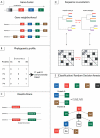Deciphering protein-protein interactions. Part II. Computational methods to predict protein and domain interaction partners
- PMID: 17465672
- PMCID: PMC1857810
- DOI: 10.1371/journal.pcbi.0030043
Deciphering protein-protein interactions. Part II. Computational methods to predict protein and domain interaction partners
Abstract
Recent advances in high-throughput experimental methods for the identification of protein interactions have resulted in a large amount of diverse data that are somewhat incomplete and contradictory. As valuable as they are, such experimental approaches studying protein interactomes have certain limitations that can be complemented by the computational methods for predicting protein interactions. In this review we describe different approaches to predict protein interaction partners as well as highlight recent achievements in the prediction of specific domains mediating protein-protein interactions. We discuss the applicability of computational methods to different types of prediction problems and point out limitations common to all of them.
Conflict of interest statement
Figures


Similar articles
-
Functional evaluation of domain-domain interactions and human protein interaction networks.Bioinformatics. 2007 Apr 1;23(7):859-65. doi: 10.1093/bioinformatics/btm012. Bioinformatics. 2007. PMID: 17456608
-
Predicting protein-peptide interactions via a network-based motif sampler.Bioinformatics. 2004 Aug 4;20 Suppl 1:i274-82. doi: 10.1093/bioinformatics/bth922. Bioinformatics. 2004. PMID: 15262809
-
Principles of protein-protein interactions.Bioinformatics. 2002;18 Suppl 2:S249. doi: 10.1093/bioinformatics/18.suppl_2.s249. Bioinformatics. 2002. PMID: 12386009
-
Analyzing molecular interactions.Curr Protoc Bioinformatics. 2003 May;Chapter 8:Unit8.1. doi: 10.1002/0471250953.bi0801s01. Curr Protoc Bioinformatics. 2003. PMID: 18428708 Review.
-
Rigid-Docking Approaches to Explore Protein-Protein Interaction Space.Adv Biochem Eng Biotechnol. 2017;160:33-55. doi: 10.1007/10_2016_41. Adv Biochem Eng Biotechnol. 2017. PMID: 27830312 Review.
Cited by
-
Determining confidence of predicted interactions between HIV-1 and human proteins using conformal method.Pac Symp Biocomput. 2012:311-22. Pac Symp Biocomput. 2012. PMID: 22174286 Free PMC article.
-
Protein-protein interaction map is a key gateway into liver regeneration.World J Gastroenterol. 2010 Jul 28;16(28):3491-8. doi: 10.3748/wjg.v16.i28.3491. World J Gastroenterol. 2010. PMID: 20653057 Free PMC article. Review.
-
Large-scale prediction of protein-protein interactions from structures.BMC Bioinformatics. 2010 Mar 18;11:144. doi: 10.1186/1471-2105-11-144. BMC Bioinformatics. 2010. PMID: 20298601 Free PMC article.
-
Thermodynamic Properties of Water Molecules at a Protein-Protein Interaction Surface.J Chem Theory Comput. 2011 Nov 8;7(11):3514-3522. doi: 10.1021/ct200465z. Epub 2011 Sep 20. J Chem Theory Comput. 2011. PMID: 24554921 Free PMC article.
-
Heterodimer Binding Scaffolds Recognition via the Analysis of Kinetically Hot Residues.Pharmaceuticals (Basel). 2018 Mar 16;11(1):29. doi: 10.3390/ph11010029. Pharmaceuticals (Basel). 2018. PMID: 29547506 Free PMC article.
References
-
- Moreno-Hagelsieb G, Collado-Vides J. A powerful non-homology method for the prediction of operons in prokaryotes. Bioinformatics. 2002;18(Supplement 1):S329–S336. - PubMed
Publication types
MeSH terms
Substances
Grants and funding
LinkOut - more resources
Full Text Sources
Other Literature Sources
Research Materials

